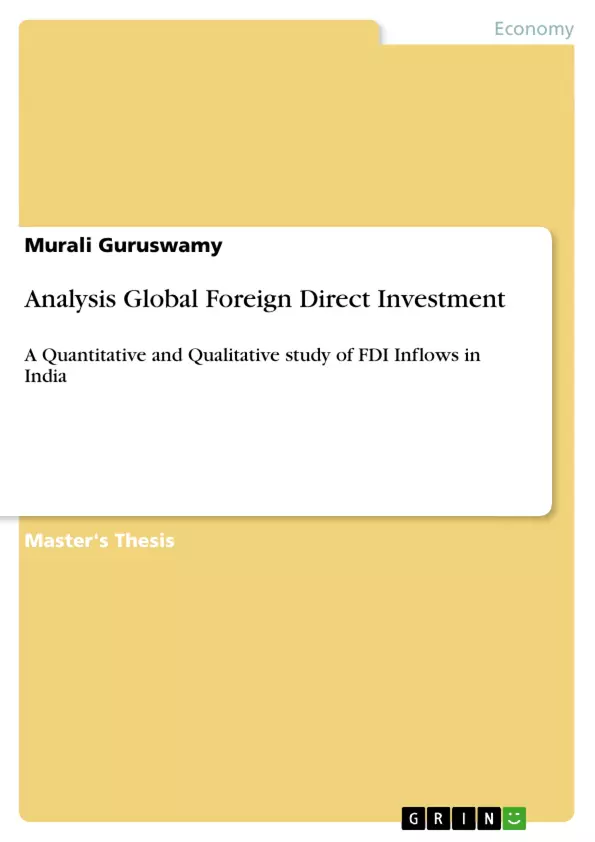The research report is based on studying foreign direct investments and global FDI flows. The primary part of the study focuses on understanding Foreign Direct Investment and its global flows using reports and handouts issued by economic organizations and departments. The secondary part of the research focuses on studying FDI flows between developed and developing economies. The study attempts to determine the key drivers for the FDI and determinants of FDI, using traditional FDI models and frameworks presented by research scholars and authors. Laterally, the research focuses on exploring the relationship between the determinants of FDI and advantages offered by host developing economies. The final part of the study focuses on analyzing the FDI trends in India and its likely impact on the retail trade and country’s economy. The primary objectives of the study was to study the historical and present trends in FDI flows in India and contrast the outcomes with China and United Kingdome using Dunning’s OLI paradigm and Differential rates of return. Finally, the study concludes of analyzing the outputs gathered through primary data collection methods, surveys, interviews and historical analysis, presenting the readers about the FDI flows between developed and developing economies.
In the theoretical part of the research, the study attempts to explore the relationship between foreign direct investments and the motives for the firm’s to indulge in foreign direct investments. The literature part also focused defining recent trends in FDI inflows in India and its likely impact on the retail market. Different theories and models were contrasted to gain conceptual knowledge about the area of interest of the study.
In the analysis and findings part, the findings that were obtained using primary and secondary data were presented with the brief interpretation in a graphical format to communicate message in a quantifiable manner.
In addition, when findings of the study are related with literature review. The study emphasizes on the fact that foreign direct investment is an important source of capital for development of nation’s economy. In addition, there is an increased flow of FDI towards developing countries rather than developed countries, because the advantageous factors offered by the developing nations.
[...]
Inhaltsverzeichnis (Table of Contents)
- Declaration
- Acknowledgement
- Abstract
- Chapter 1: Introduction
- 1.1 Introduction
- 1.2 Background of Study
- 1.3 Statement of the Problem
- 1.4 Research Objectives
- 1.5 Research Questions
- 1.6 Scope and Limitations
- 1.7 Significance of the Study
- 1.8 Organization of the Study
- Chapter 2: Literature Review
- 2.1 Introduction
- 2.2 Theoretical Framework
- 2.3 Foreign Direct Investment
- 2.4 Drivers of Foreign Direct Investment
- 2.5 Determinants of Foreign Direct Investment
- 2.6 FDI Flows and Global Trends
- 2.7 FDI Inflows and Outflows
- 2.8 The Role of FDI in Developing Economies
- 2.9 FDI in the Retail Sector
- 2.10 FDI and Economic Growth
- 2.11 Policy Implications
- Chapter 3: Research Methodology
- 3.1 Introduction
- 3.2 Research Design
- 3.3 Data Collection Methods
- 3.4 Data Analysis Techniques
- 3.5 Ethical Considerations
- Chapter 4: Data Analysis and Findings
- 4.1 Introduction
- 4.2 Analysis of FDI Flows in India
- 4.3 Comparison of FDI Flows in India, China, and the United Kingdom
- 4.4 Determinants of FDI in India
- 4.5 Impact of FDI on the Retail Sector in India
- 4.6 Policy Recommendations
- Chapter 5: Conclusion
Zielsetzung und Themenschwerpunkte (Objectives and Key Themes)
This dissertation investigates foreign direct investment (FDI) flows and their impact on developing economies, particularly focusing on the Indian retail sector. The main objective of the research is to analyze the historical and present trends of FDI flows in India, contrasting them with those in China and the United Kingdom.- Understanding the global trends and drivers of FDI
- Examining the determinants of FDI inflows, including economic, political, and regulatory factors
- Analyzing the impact of FDI on the retail sector in India
- Comparing FDI patterns and outcomes in India, China, and the United Kingdom
- Developing policy recommendations to attract and optimize FDI inflows in India
Zusammenfassung der Kapitel (Chapter Summaries)
- Chapter 1: Introduction: This chapter provides an overview of the research topic, outlining the background, statement of the problem, research objectives, and the organization of the dissertation. It also discusses the significance of the study and the limitations of the research.
- Chapter 2: Literature Review: This chapter presents a comprehensive overview of the relevant theoretical frameworks and existing research related to FDI, including drivers and determinants, global trends, and the role of FDI in developing economies. The chapter also examines the literature on FDI in the retail sector and its impact on economic growth.
- Chapter 3: Research Methodology: This chapter details the research design, data collection methods, data analysis techniques, and ethical considerations employed in the study. The methodologies used to gather and analyze data are explained in detail.
- Chapter 4: Data Analysis and Findings: This chapter presents and analyzes the collected data, providing insights into FDI flows in India, a comparative analysis with China and the United Kingdom, and the impact of FDI on the Indian retail sector. The chapter also includes policy recommendations based on the research findings.
Schlüsselwörter (Keywords)
This research focuses on foreign direct investment (FDI), global FDI flows, developing economies, retail sector, India, China, United Kingdom, Dunning's OLI paradigm, determinants of FDI, economic growth, policy implications, and comparative analysis.- Quote paper
- MBA Murali Guruswamy (Author), 2014, Analysis of Global Foreign Direct Investment, Munich, GRIN Verlag, https://www.hausarbeiten.de/document/271386


